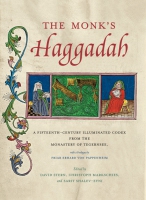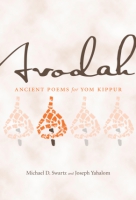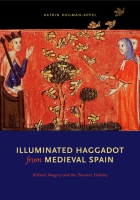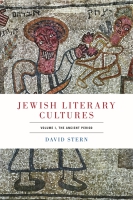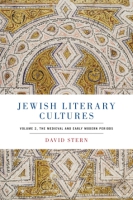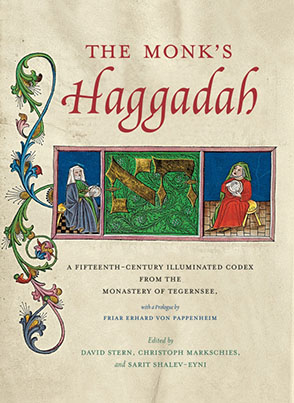
The Monk’s Haggadah
A Fifteenth-Century Illuminated Codex from the Monastery of Tegernsee, with a prologue by Friar Erhard von Pappenheim
Edited by David Stern, Christoph Markschies, and Sarit Shalev-Eyni
The Monk’s Haggadah
A Fifteenth-Century Illuminated Codex from the Monastery of Tegernsee, with a prologue by Friar Erhard von Pappenheim
Edited by David Stern, Christoph Markschies, and Sarit Shalev-Eyni
“This book wonderfully proves the value of collaborative research. The introduction describes how this collaboration came about and is by itself a little masterpiece. Like a detective story, it chronicles how the researchers gradually came to recognize that the Haggadah and its Latin—and very Christian—preface constitute one of the most remarkable testimonies in both image and word of the complex character of Jewish-Christian relations in the fifteenth century. Yet the manuscript, even after the collaborators’ fascinating findings, remains enigmatic and indeed mysterious. This is simply an extraordinary book about an extraordinary artifact.”
- Description
- Reviews
- Bio
- Table of Contents
- Sample Chapters
- Subjects
“This book wonderfully proves the value of collaborative research. The introduction describes how this collaboration came about and is by itself a little masterpiece. Like a detective story, it chronicles how the researchers gradually came to recognize that the Haggadah and its Latin—and very Christian—preface constitute one of the most remarkable testimonies in both image and word of the complex character of Jewish-Christian relations in the fifteenth century. Yet the manuscript, even after the collaborators’ fascinating findings, remains enigmatic and indeed mysterious. This is simply an extraordinary book about an extraordinary artifact.”
“Jewish-Christian relations in the Middle Ages represent a challenging and often painful subject that defies easy categorization in terms of what too often is called, in anodyne, even evasive, terms, the ‘Judeo-Christian’ tradition. This brilliant collaboration between three experts in their respective fields uncovers an exceptional, yet also exemplary, case of a hybrid haggadah that, although written by a Jewish scribe, was adapted in a variety of ways for use by Christian monks both during and after its production. A testimony to interdisciplinary research, the book uncovers an astonishing episode in the long history of Christian Hebraism. University professors, Christian humanists, Bavarian monks, and anonymous artists are the cast of characters that make of this study a fascinating piece of detective work and a reminder of the complexity of any effort to capture historical truth. Especially admirable is the editors' willingness to consider multiple solutions to the conundrum the Tegernsee Haggadah presents. The reader is invited to think along with the editors. In the process, a world of Jewish-Christian interaction more complex than commonly imagined is revealed with precision and eloquence.”
“The Tegernsee Haggadah in Munich is a truly unique book. This edition reproduces an unusual illuminated manuscript. It also includes both a detailed description of the book and a meticulous reconstruction of its production, its history, and its eventual function as—amazingly enough—a study book for monks in order to familiarize themselves with Jewish rituals. Containing a Latin treatise, it was supposed to teach the monks to read the Haggadah within the framework of contemporary blood libels. David Stern, Sarit Shalev-Eyni, and Christoph Markschies leave no stone unturned in unraveling the story of an extraordinary artifact, and the somewhat unusual role a book could play in the Jewish-Christian coexistence of late medieval Europe.”
“The Monk’s Haggadah is at once a beautiful facsimile edition of a remarkable Haggadah manuscript and also a collaborative edition, translation, and analysis of text, image, and material object. . . . This is the first full-length study of the manuscript, and David Stern’s introduction describes the collaboration that brought the volume into being. It makes for a great story, and Stern tells it as the intellectual adventure it clearly was. Fourteen years in the making, The Monk’s Haggadah represents quite an achievement and demonstrates the power of multidisciplinary collaborative work.”
“In his moving and surprisingly gripping introduction to The Monk’s Haggadah, Harvard scholar David Stern describes the journey that he and his talented co-editors, Christoph Markschies and Sarit Shalev-Eyni, took in uncovering the mysteries of the manuscript and creating this handsome critical version. . . . Together with transcriptions and translations of the Prologue, text, and marginalia, the new book contains marvelous essays that make it a comprehensive account of the 500-year life of this mysterious manuscript.”
“A timely and necessary reminder of the value of humanistic scholarship conducted in the spirit of both exacting inquiry and good faith.”
“Offers a superb example of what can happen when scholars who specialize in different but parallel histories of the book combine their efforts to uncover how competing cultures worked together and against each other to create books. . . . This volume is an impressive model for inclusive manuscript studies than can help us understand more clearly the complex relationships between separate but adjoining historical communities of the book.”
David Stern is the Moritz and Josephine Berg Professor of Classical Hebrew Literature at the University of Pennsylvania.
Christoph Markschies is the Chair of Ancient Christianity at Humboldt-Universität zu Berlin.
Sarit Shalev-Eyni is Professor of History of Art at the Hebrew University of Jerusalem.
Contents
List of Illustrations
1. The Monk’s Haggadah (Munich Codex Hebrew 200): An Introduction
David Stern
2. The Making of the Codex: Scribal Work, Illumination, and Patronage
Sarit Shalev-Eyni
3. The History of the Codex and the Christian Theological Background of Erhard’s Prologue
Christoph Markschies
4. The Hebraist Background to Erhard’s Prologue
David Stern
5. Codicology and Description of the Manuscript
Sarit Shalev-Eyni
6. The Prologue to the Haggadah by Erhard von Pappenheim (Latin Text)
Edited by Christoph Markschies with Erik Koenke and Anna Rack-Teuteberg
7. The Prologue to the Haggadah by Erhard von Pappenheim (English Translation)
Translated by Erik Koenke with David Stern
8. The Passover Haggadah (in Codex Hebrew 200)
Translated by David Stern
Notes
Every book has a story, and the story of the book you are now reading—this facsimile edition of the Tegernsee Haggadah, Codex Hebrew 200 in the Bayerische Staatsbibliothek (BSB) in Munich—is especially fascinating. It is, in fact, two stories—one of them, the history of the codex’s own composition and production in the fifteenth century; the other, the tale of how, six centuries later, the coeditors of the present volume managed to reconstruct that earlier history. Both are stories of collaborations. Like most medieval codices, the Tegernsee Haggadah was the product of the joint work of multiple figures—the scribe who wrote the text of the Haggadah; vocalizers who added the pronunciation marks and proofread the text; the unknown artist(s) who illustrated it; an unknown patron and/or commissioner of the volume; a fifteenth-century monk who wrote a lengthy prologue in Latin to the Haggadah; and an abbot and monastery librarian who also played significant roles in the final formation of the codex as we know it today. But the scholarship that produced the findings in this facsimile edition was also the product of a collaboration—between myself, David Stern, a scholar of classical Jewish literature and culture; Christoph Markschies, a professor of Christian history and institutions in antiquity and the Middle Ages; and Sarit Shalev-Eyni, an art historian specializing in medieval Hebrew manuscripts—and this collaboration was truly significant because its findings could not have been produced by any one of us alone. And like most human collaborations, ours was partly the result of deliberately made decisions, diligent work, and patient persistence, but, equally so, of accidents, fortuity, and sheer lucky coincidence. The role of fortuity and coincidence in the history of scholarship has not yet been adequately explored, but this volume makes a strong case that the subject is worth investigating.
In this introduction, I want to present both stories in brief. In the three substantial essays that follow, the reader will find extensive and detailed discussions of each of the codex’s major aspects—the Haggadah’s own history as a book and the exceptional nature of its illustrations and artistic program; the Christian theological background of the prologue and the later history of the Haggadah; and the Hebraist background to the Latin prologue and its author’s knowledge of Jewish practice. This facsimile also contains a critical edition of the Latin prologue, a scholarly translation into English of the text, as well as a translation of the text of the Haggadah in the codex. In this introductory essay, I will narrate the story of our reconstruction of the Haggadah’s history and, in the process, sum up our major findings and present the different, often speculative conclusions we have drawn.
The story begins in the academic year 1999–2000, as the millennium turned, when Christoph Markschies and I were both members of a working group of scholars at the Institute for Advanced Studies at the Hebrew University in Jerusalem. Each of us was immersed in our own projects. Mine dealt with the material history of several classic Jewish books, one of which was the Passover haggadah. Much of my research involved the massive collection of microfilms of Hebrew manuscripts in the Institute for Microfilmed Hebrew Manuscripts, located in the (now) National Library of Israel on the Givat Ram campus of the Hebrew University. This institute is one of the crowning achievements of modern cultural Zionism. Originally the idea of David Ben Gurion, the first prime minister of the State of Israel, who proposed its founding in 1950, the institute today owns microfilms of some seventy-four thousand Hebrew manuscripts from the ninth century until the present; these microfilms represent over 90 percent of the surviving Hebrew manuscripts in the world. Because this institute exists, a scholar who wishes to consult a Hebrew manuscript no longer needs to travel across oceans and continents to visit separate libraries; he or she can simply come to Jerusalem and consult the microfilm collection. For obvious reasons, the institute is even more valuable for any scholar who wishes to consult multiple manuscripts of a text at the same time.
This is what I needed to do. As part of my research, I had to inspect every haggadah manuscript preserved in microfilm at the institute. This project sounds more daunting than it actually was, since what I wanted to check took about two minutes in each microfilm. (It took me longer to fill out the request slips than to look at the microfilms themselves!) And so, several days into the project, as I was zooming from one microfilm reel to the next, I suddenly glimpsed a bunch of pages in Latin, and then a haggadah with rather striking illustrations and, whizzing by me, haggadah pages with Latin inscriptions. I immediately stopped the microfilm reader, backed up to see if I was hallucinating, and there it was, several folios in a handsome Latin script followed by the illustrated pages of a professionally written haggadah, some with Latin marginal inscriptions. How interesting! I thought to myself, and then I ordered a printout of the Haggadah in order to look at it more carefully. The printout arrived, I put it on my desk, and it promptly got buried beneath a pile of other papers for several months.
Now, I was not the first person to take note of this Haggadah. It is mentioned and briefly commented upon in studies of illustrated medieval haggadahs. The Israeli codicologist Malachi Beit-Arié has called attention to its scribe for his considerable scribal skills, particularly for his techniques in justifying left margins. And of course, the librarians and bibliographers of the Stadtbibliothek’s Hebraica collection have properly catalogued the Haggadah in their publications. German scholars interested in Christian Hebraism have also noted it. But no one, so far as I know, had taken serious note of the Latin prologue and asked about its connection to the Haggadah, which is what initially most intrigued me.
Now, as it happens, I studied medieval Latin in graduate school, but that was long ago, and I was never a particularly good Latinist. To my good fortune, Christoph Markschies and I had become friends through our participation in the group at the Institute for Advanced Studies. After several months, once the microfilm printout resurfaced on my desk and I remembered it, I spoke to Christoph and asked him if he would be willing to help me read the Latin text. He graciously agreed, and we spent several hours reading the first section, but the work was very time-consuming, and we had our own projects to complete. Nonetheless, what we read had sparked our curiosity, and we decided to continue. Markschies proposed that he take a photocopy of the manuscript back to Germany and have a doctoral student in medieval studies there transcribe the text and do a preliminary translation into German. At the time, Markschies had just been appointed professor of the history of Christianity at the University of Heidelberg. At the close of the year, Christoph returned to Germany and I to Philadelphia and my position at the University of Pennsylvania.
Some nine months later, in June 2000, I received the following e-mail from Christoph:
Dear David: On Monday or Tuesday I will send you the whole Latin text of our document and the translation. For the moment we can say the following: our author is a monk, he is acquainted with many details, not only of the Haggadah but also of all the customs around the Haggadah. In the next attachment you will find the whole translation of the terrible Christian legend that Jews drop the blood of a child into the matzah. It is the first time that I have read this in a primary source (not in secondary literature), and I was really shocked when I went through the translation. On the one hand, the author is so well informed; on the other, he transmits the evil legend in the manner of a person who has never seen a Jew! This looks to me like a Janus-Kopf (Janus-head), our German word for a double-faced person.
In these early remarks, Markschies presciently captured the unique character of the prologue and its author’s personality.
The section to which Christoph referred in his e-mail is the single most sensational passage in the prologue. It is found near the beginning, where the prologue’s author details the preparations for Passover; in the course of his account he describes how the Jews prepare the six special matzot called matzot mitzvah.
[T]he previously mentioned six principal cakes of unleavened bread are prepared before the others in a very special way with the blood of Christian infants.
If there is fresh blood, the head of the household sprinkles some drops—more or fewer, depending on how much he has—into the prepared batter, even though, they say, a single drop will suffice. If there is no fresh blood, he grinds dried blood into powder, and then hydrates and sprinkles it as explained previously. While he mixes and sprinkles the blood, however, he does not allow in anyone except the most faithful. The other, regular cakes of unleavened bread, those without blood, are usually called matzos, and in the vernacular spoken in many places, matizin.
The accusation that Jews used the blood of a Christian child in preparing matzot for Passover was by the fifteenth century the standard and familiar blood libel. According to our author, however, it was not only in preparing matzot that Jews used Christian blood. When he comes to describing the seder (the ritual banquet held on the first two nights of Passover, for which the Haggadah serves as both text and script) and the pouring of the first glass of wine, he writes, “Once they have set the table with the individual items mentioned previously, the leader of the household sits at the head of the table with his chalice filled with wine before him. Then . . . he takes a single drop from another chalice full of Christian blood, and putting it in his wine, he says: ‘This is the blood of a Christian child.’ Once his own wine is mixed with the blood, he pours a drop into every other chalice” (¶19 [15]). The idea that Jews place drops of Christian blood in the ceremonial wine in addition to the matzot is, in fact, unprecedented and almost entirely undocumented elsewhere, as I discuss in my chapter.
These references to Jewish use of Christian blood in the matzah and wine at the seder are, as Christoph had remarked, one side—the dark side, as it were—of the prologue. Its other side is the author’s exceptional familiarity with the Haggadah and the seder as it was practiced by Ashkenazi Jews in the fifteenth century, and his objectivity in reporting his knowledge. For one thing, his Hebrew is excellent. He translates large parts of the Haggadah accurately, and he even recognizes a mistake the scribe made at one point in transposing two passages in the incorrect order. His knowledge of Jewish customs and practice is extensive and (with the obvious exception of the blood libel instances) generally accurate. He knows that the candles used for the search for leaven, ḥametz, on the night before Passover should be of wax, not of oil or covered with shades; that its flame should be moderately bright but should not pose a danger of starting a fire; that, after searching for ḥametz, one must carefully guard what one has found lest a mouse carry it away and make a second search necessary. Similarly, he knows that matzah is made out of dough of the quantity of forty-three and one-fifth eggs. Even more impressively, he relates arcane Ashkenazi customs and folk traditions, like the belief in the tokofah (Hebrew: tekufah)—then a widespread belief (now almost completely forgotten) that, at the period of the two equinoxes and the solstices, drops of poisonous rainwater fall from heaven and poison any open water source into which they fall; he even knows that the water used to prepare matzah is not subject to contamination by the tekufah drops. The accuracy of all these details and beliefs is corroborated by contemporary fifteenth-century Ashkenazi halakhic tracts like the Sefer Maharil of Jacob Moellin (1360–1427), the foremost Ashkenazi Talmudist of his generation.
Perhaps the most notable fact about the prologue is its author’s tone in reporting all these Jewish practices and beliefs. On the one hand, he explicitly mocks Jewish beliefs like the tekufah as bizarre and ridiculous. He is convinced of the falseness, even perniciousness, of Jewish faith; he repeats the standard mendicant accusation that not only is the Judaism of the rabbis opposed to the true faith of Christianity, but the ordinances of the rabbis also transgress biblical law. He notes several times that there is no mention in the Haggadah of the sacrifice of the lamb—the core of the biblical observance of Passover—and that most of the practices Jews do observe at the seder are nowhere to be found in the Bible. So, too, he is convinced that the Jews hate Christians and Christianity and that they drink Christian blood “not out of any necessity but only out of hatred and contempt for Christ” (¶14 [13]).
On the other hand, when the author describes the Jews and their practices, he does not demonize them. He does not knowingly report false beliefs or practices that Jews observe—to all appearances, he truly believes in the veracity of the blood libel—nor does he engage in wild speculation about Jewish “magic,” a common theme of most earlier medieval Christian accounts of the Jews, particularly those that relate the blood libel. While it would be wrong to say that the author is “sympathetic” to his Jewish subjects, it is not inaccurate to describe his approach as reporterly, almost ethnographic; indeed, this prologue is our earliest surviving “ethnography” of Jewish practice, albeit one with a clearly polemical and theologically tendentious motive. Moreover—and perhaps most important—he recognizes the external similarities between the Jewish rituals of the seder and those of the Eucharist. Indeed, his main interest in the Haggadah derives from his realization that both Christ at the Last Supper and the holy church “up to this day in the Office of the Mass imitate the . . . rite of the paschal supper”—albeit in the truer, more spiritual sense of Christian practice (¶67 [66]).
Such were the initial impressions that Christoph and I had of the prologue when we first read it. The author of the prologue never identifies himself. He does, however, refer several times to the confessions of the Jews of Trent as the source of his knowledge of Jewish practice, and at one point he tells us that he “translated the confessions into our vernacular language”—namely, German—in a translation that “contained twenty-four complete notebooks” (¶12 [12]. This statement proved to be an extremely important clue to his identity. The confessions of the Jews of Trent refers to those made at the famous ritual murder trial that took place in the town of Trent (then located at the southern border of the Holy Roman Empire of the German Nation, today in northern Italy, about seventy-five miles from the Austrian border). In 1475, the Jews of Trent, a small community of about thirty people, were accused of murdering the Christian child Simon of Trent in order to use his blood for the Passover seder. Largely on account of the new technology of print, the Trent blood libel quickly became famous (or infamous) as the most prominent blood libel trial of the late fifteenth century, with reports and depictions of the purported ritual murder disseminated throughout Europe in the form of woodcuts and broadsides. Hartman Schedel’s woodcut in the Nuremberg Chronicle (Nuremberg, 1493) was probably the most publicized of all these representations (see fig. 1). As numerous scholars have remarked, the scene of the infant Simon being bled to death by a group of Jews clearly mimics the iconography of a Holy Family scene.
By this point in our research, Christoph and I had decided that the manuscript—the Haggadah and the prologue—was worthy of publication. We decided to meet in the summer and go to Munich together to examine the codex in person, and, if possible, request permission from the BSB to publish it. That July, as I was making my travel plans, I realized that I would need lodgings in Munich, and I called a good friend, Michael Ryan, then the head of Special Collections at Penn, to ask if he could recommend an inexpensive hotel or pension in Munich. He could not, but he suggested that I call and ask “Nico,” who spent long periods of time in Munich working at the BSB.
“Nico” is the affectionate nickname of Professor Emeritus of Classics Georg Nicolaus Knauer, a distinguished Latinist who came to Penn from Germany in 1975. Since his retirement, he has been working assiduously on a history of Latin and early vernacular translations of Homer’s works. I had first met Professor Knauer shortly after I came to Penn, and virtually from the time of our first meeting every time we saw each other in passing, he would call out to me, “I have to speak with you; I have a manuscript with some Hebrew and I need your help to read it.” Alas, this exchange had become a kind of ritual between us; we never managed to find the time to look at the manuscript together, but we were on very friendly terms. So I called Nico and asked him for a recommendation for a pension; he immediately gave me the name of the place he used, and I happily booked a room there.
That July I flew to Frankfurt and took the train to Heidelberg, where Christoph and I planned to compare notes before going together to Munich. As soon as I walked into his apartment, he proudly announced, “I have discovered the identity of the author of our prologue.” And then he lifted from the table Ronnie Po-chia Hsia’s mesmerizing book Trent 1475, a harrowing account of the ritual murder trial as recounted in a remarkable manuscript now owned by the library of the Yeshiva University Museum; the manuscript consists of a translation into German of the complete Latin protocols of the Trent trial. Christoph opened the book to page 142 and told me to read footnote 10: “The identity of the translator of the Yeshiva manuscript has been brought to my attention by Professor G. N. Knauer of Philadelphia as this book goes to press. . . . Professor Knauer . . . advances the argument that the Erhard confessor identified with the translator of the German text was not Erhard Streitperger but another Dominican, Erhard von Pappenheim, friend of Johannes Reuchlin and confessor in Altenhohenau, a Dominican convent on the River Inn in the vicinity of Innsbruck.” In other words, the Yeshiva University manuscript was the German translation that the author of our prologue stated that he had composed, and this Erhard von Pappenheim was also the author of our prologue. That, however, was not the first thing that came out of my mouth. “G. N. Knauer!” I exclaimed. “That’s Nico! He just gave me the name of a pension in Munich. What an amazing coincidence! I have to tell him as soon as I get back to Philadelphia.” So much for fortuity and scholarship and small worlds.
The next day Christoph and I took a train to Munich, inspected the manuscript, and spoke to the head of special collections at the BSB at the time, Dr. Ulrich Montag, who, it turned out, was very well disposed to our idea of publishing a facsimile if we could find a publisher. Then we inspected the Haggadah itself, and were even more impressed when we looked at the codex in person. The beauty of the script and its decoration and the charming quality of the illustrations, together with the incredible fascination of the prologue, convinced us that we had to publish the entire manuscript as a facsimile accompanied by English translations of the prologue and the Haggadah itself and scholarly essays by Christoph and myself. With this plan, Christoph returned to Heidelberg, while I remained in Munich for several more days, during which I continued to study the manuscript and also went through the file of material that the BSB had accumulated about the codex—though, as we will see shortly, I did not go through the file carefully enough.
Mailing List
Subscribe to our mailing list and be notified about new titles, journals and catalogs.
